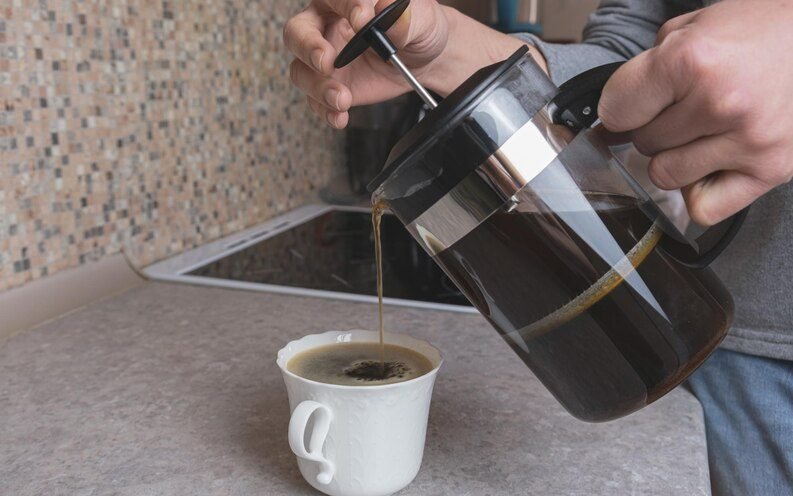From Bean to Cup: Discovering the Art of Brewing Bali Kintamani Coffee
Discover the delicious flavors and fascinating history of Bali Kintamani coffee. Join us as we investigate the remarkable coffee’s sustainable agricultural practices, roasting procedures, and brewing ways. Awaken your senses and learn how to make Brewing Bali Kintamani coffee.

Table of Contents
The History and Origins of Bali Kintamani Coffee
Bali Kintamani coffee has a long and illustrious history dating back centuries. Dutch colonists brought coffee trees to Bali in the late nineteenth century. Since then, Bali’s coffee business has thrived, with Kintamani becoming one of the island’s most known coffee-growing regions. The mountains’ volcanic soil and distinct atmosphere provide ideal conditions for growing high-quality coffee beans. Over decades, the farmers in this region have polished their trade, passing along their knowledge and expertise to assure the beans’ outstanding quality.
Also Read: Everything You Need to Know About Arabica Bali Kintamani Coffee
The distinctive features of Bali Kintamani coffee beans are due to the volcanic soil and altitude at which they are grown. The volcanic ash in the soil gives the beans a particular flavor profile, giving them a rich, earthy flavor with hints of citrus and flowery overtones. The altitude, in conjunction with the mild temperatures and abundant rainfall, slows the development of the coffee cherries, allowing the flavors to develop more fully. These elements contribute to the distinctive and nuanced flavors of Bali Kintamani coffee.
The espresso method is ideal for individuals who desire a more concentrated and strong coffee experience. Hot water is blasted through finely ground coffee at high pressure using a specialized espresso machine, resulting in a short, concentrated shot of coffee. This technique is ideal for encapsulating the complex tastes of Bali Kintamani coffee in a single drink.
Exploring Different Brewing Methods for Bali Kintamani Coffee
Pour-over Method

Step-by-Step Guide to the Pour-Over Method:
- Grind the Beans: Start by grinding your Bali Kintamani coffee beans to a medium-coarse consistency. This ensures optimal extraction and flavor.
- Prepare the Filter and Equipment: Place a paper filter in your pour-over dripper or coffee maker. Rinse the filter with hot water to eliminate any paper taste and preheat the equipment.
- Add Coffee and Bloom: Place the ground coffee into the filter, leveling it out. Slowly pour a small amount of hot water (about twice the weight of the coffee grounds) in a circular motion, allowing the coffee to bloom. This releases carbon dioxide and enhances flavor extraction.
- Begin the Pour: Starting from the center, pour hot water (just below boiling point) in a slow and controlled manner, using a circular motion. Ensure that all the coffee grounds are evenly saturated.
- Maintain a Steady Pour: Continue pouring water in a slow and steady manner, maintaining an even flow over the coffee grounds. Avoid pouring directly onto the filter to prevent over-extraction.
- Wait and Drip: Allow the coffee to drip through the filter into your cup or serving vessel. This process may take a few minutes, so be patient.
- Serve and Enjoy: Once the dripping has slowed down, remove the dripper or coffee maker. Pour the freshly brewed Bali Kintamani coffee into your favorite cup and savor the enticing flavors and aromas.
French press Method

Step-by-Step Guide to the French Press Method:
- Measure and Grind: Start by measuring the desired amount of Bali Kintamani coffee beans based on your preferred coffee-to-water ratio. Coarsely grind the beans for optimal extraction.
- Heat the Water: Boil water to just below boiling point (around 200°F or 93°C). Preheating the French press with hot water is optional but can help maintain the temperature during brewing.
- Add Coffee and Water: Place the coarsely ground coffee into the French press. Slowly pour hot water over the coffee, ensuring all the grounds are saturated. Use a gentle stir or swirl to ensure even extraction.
- Steep the Coffee: Place the plunger and lid on the French press but do not plunge yet. Let the coffee steep for about 4 minutes. Adjust the steeping time based on your taste preferences for a stronger or milder brew.
- Plunge and Pour: After the desired steeping time, slowly and steadily push the plunger down, separating the coffee grounds from the liquid. Pour the brewed Bali Kintamani coffee into your cup or serving vessel.
- Serve and Enjoy: Pour the freshly brewed coffee into your favorite mug and savor the delightful flavors and aromas of Bali Kintamani coffee. If desired, add milk, sugar, or other flavorings according to your taste.
Espresso methods

Step-by-Step Guide to the Espresso Method:
- Grind the Beans: Start by grinding your Bali Kintamani coffee beans to a fine consistency, suitable for espresso brewing. The grind should be fine enough to create a smooth and concentrated shot.
- Preheat the Espresso Machine: Ensure your espresso machine is properly preheated and ready for brewing. This helps maintain a consistent temperature throughout the process.
- Portafilter Preparation: Insert a clean and dry portafilter into the espresso machine. Distribute the freshly ground coffee evenly into the portafilter basket. Tamp the coffee grounds firmly and evenly using a tamper to create a compact puck.
- Insert the Portafilter: Attach the portafilter back into the espresso machine. Ensure it is properly locked in place and secure.
- Extraction Time and Pressure: Start the espresso extraction process. The ideal extraction time for a single shot of espresso is around 25-30 seconds. The espresso should flow out in a steady stream, with the first drops appearing as a dark, syrupy liquid.
- Observe the Crema: Watch for the formation of a thick, golden crema on top of the espresso shot. This indicates a well-extracted and flavorful shot.
- Adjust and Fine-Tune: If the extraction time is too fast (under 20 seconds) or too slow (over 30 seconds), adjust the grind size accordingly. Finer grind for slower extraction and coarser grind for faster extraction.
- Serve and Enjoy: Once the desired extraction time is achieved and the crema is formed, stop the extraction by turning off the espresso machine. Pour the rich and aromatic Bali Kintamani espresso shot into a preheated cup or demitasse.
Also Read: Pour Over Coffee vs Drip: Which Brewing Method is Right for You?
Tips for Brewing the Perfect Cup of Bali Kintamani Coffee
To ensure that you brew the perfect cup of Bali Kintamani coffee, here are a few tips to keep in mind:
- Use freshly roasted coffee beans: For the best flavor, opt for freshly roasted Bali Kintamani coffee beans. Look for a roast date on the packaging and aim to use the beans within a few weeks of the roast date.
- Grind your coffee just before brewing: Grinding your coffee beans right before brewing helps to preserve the flavors and aromas. Invest in a quality burr grinder for the best results.
- Use the right water-to-coffee ratio: The ideal ratio is generally around 1:16, which means one part coffee to 16 parts water. However, feel free to adjust this ratio to suit your personal taste preferences.
- Experiment with water temperature: Different brewing methods may require different water temperatures. As a general guideline, aim for water temperature between 195°F and 205°F for optimal extraction.
- Practice patience: Brewing Bali Kintamani coffee requires time and patience. Take your time to enjoy the process and savor each step, from grinding the beans to pouring the water.
Where to Buy Authentic Bali Kintamani Coffee Beans
There are several reliable sources where you can find original Balinese Kintamani coffee beans. Look for coffee specialty cafes that source coffee beans directly from the Kintamani area in Bali. In addition, online shops and coffee subscription services offer a wide selection of Bali Kintamani coffee beans that can be delivered easily to your door. To make sure you’re buying beans from the highest quality and ethical sources, read customer reviews and look for certification.
If you specifically want to buy green beans FandB Tech Indonesia is a recommended destination. They specialize in sourcing and providing specialty coffee products.
Conclusion
The art of brewing Bali Kintamani coffee is a journey that combines history, craftsmanship, and sustainability from bean to cup. The distinct flavors and smells of Bali Kintamani coffee are a testament to the growers’ dedication and expertise in cultivating these fine beans. The Kintamani region has created a coffee that not only thrills the taste senses but also encourages environmental protection and community development by embracing sustainable cultivation practices.
Whether you brew Bali Kintamani coffee with a pour-over, French press, or espresso machine, each cup is an opportunity to appreciate the creativity and workmanship that goes into every sip. So, appreciate the flavors, delight your senses, and immerse yourself in the world of Bali Kintamani coffee for a time.











